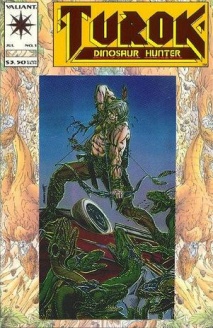
You may not know his name, and you may never visit his comic shop, but Cliff Biggers has affected you. In addition to writing the nationally distributed Comic Shop News on a weekly basis, he also played a big part in getting Mark Bagley his start at Marvel. What singled him out for an interview during Multiversity’s Look at Variant Covers, though, comes down to two articles he wrote for Comic Buyer’s Guide in February of 1994. One was about the then-recent downturn in the market, and the other was about the problems with “manufactured collectibles,” a term that fits perfectly with incentive covers. Because he showed insight into the industry then, it seemed worthwhile to see what he thinks now.

For readers who aren’t familiar with you, can you please say a little bit about your background and how you got into retailing? When and why did you start writing Comic Shop News?
Cliff Biggers: I’ve loved comics since I was 5. I went from being a reader to a fan to a fanzine writer to a fanzine publisher, and I still wanted more involvement — so what better way to be involved than to create comics (I’ve written a few comics over the years; “After Apocalypse” with Mark Bagley, “Earth Boys” with Brett Brooks and Dave Johnson in “Dark Horse Presents,” “i•Bots” for Tekno with Brett Brooks and Pat Broderick) and to own a comic shop?
I’ve been fascinated with comics retailing since I first discovered comic shops. Before I became owner of Dr. No’s, I helped the prior owner order and maintain his comics section. I bought the store in 1982. In 1985, I began doing a newsletter for the store; before long, other stores in the area were buying our logo-less newsletter and adding their own logo. That led my business partner and me to the idea that some sort of Comic Shop News might find a market; we launched it in 1987, and it’s continued weekly ever since.
Do you remember any one moment in the early 90s when you suddenly realized the comic market was in a boom?
CB: When we had that monster line for ‘The Death of Superman,’ I realized that we were seeing something the likes of which we had never seen before.
Was there a moment when it hit you the boom was over?

CB: The failure of “Turok” at Valiant and the dismal performance of many of the second-wave Image titles were pretty good indicators. But it was the abominable performance of Marvel UK, the unpopularity of ‘Heroes Reborn,’ and the distributor implosion of the later 90s that convinced me that the party was ending.
In the February 94 issue of Comic Buyer’s Guide you had two articles, one on sales declines and one on the practice of manufactured collectibles. What I found particularly interesting was the other pieces sandwiched between yours — one hyping a new X-Men card set and one on upcoming “hot” books. Were your views about the industry in the minority at the time?
CB: I don’t think so — at least not in the retailing community. At the same time, it’s worth noting that there are going to be hot books in any market, even a declining one. But I think that manufactured collectibles were a concern then, and they’re a concern now.
The glut of modern variant covers has led some fans to draw comparisons to the 90s boom, and the recent rise of enhanced covers has only increased concern. What’s your opinion of the current state of comics?
CB: Comics have never been better creatively — a great range of material, quality creators working in a wide variety of styles, a publishing renaissance, a strong indy market, and a more educated readership that appreciates the importance of enjoying what they’re reading. Comics have to be a readers’ medium, as far as I’m concerned.
At the same time, as a collector of many different things (albums, horror fiction, pulp adventures, comics, and much more), I understand the personal enjoyment of collecting the rarity, of acquiring the hard-to-find item. I appreciate the collector who wants a variant because it’s a prize item in his collection; I’m more concerned for the collector who thinks that buying variants and enhanced covers is the secret to future financial success.
Continued below
Your shop is a member of the Phantom group, and receives exclusive variants for certain issues. For people unfamiliar with the program, what is its purpose?
CB: I joined the Phantom Group for two reasons: the group’s creators, Larry and Ralph, and that they were promoting books that I thought deserved extra attention (books like “Revival,” for instance).
The Phantom Group is an affiliation of retailers who band together to create unique covers for key books from a variety of publishers. There was no Phantom Group retailer in Georgia, and we had customers asking for some of their books, so we became a participating store.
What percentage of your customers are interested in variant/incentive covers, and what aspects of variant covers seem to be the most appealing (particular artist, theme, rarity, etc)? The least?
CB: Hard to say — I’d guess that it’s about 15%-20%, although in cases where there are variant covers at cover price, the percentage might be higher. Art is the prime driver of the variant cover in our market.
Have you encountered any customers who were confused or frustrated by multiple covers? If so, what was the nature of the problem?
CB: Occasionally. We bag and price all variants over cover price, but it still confuses some readers who don’t understand why one printed copy of a comic is more expensive than another.






